September 30, 2022 – Volume 24, Issue 9
In This Issue
- Flanigan’s Eco-Logic: Patagonia
- Clean Power Matches California’s Heat Wave
- The Inflation Reduction Act of 2022
- Green Hydrogen Electrolyzers
- Little Free Library Movement
- Air Canada Orders Electric Planes
- Flanigan’s Ego-Logic Podcast Updates

Flanigan’s Eco-Logic: Patagonia
The news that Yvon Chouinard, the founder of Patagonia, and his family decided to gift their equity in the company to support climate protection hit me hard, in the best way! How wonderful. The world is full of love. And especially so, in the right places. Patagonia is one of those.
Patagonia’s founder, Yvon Chouinard, his wife and two adult children have irrevocably transferred their ownership of the large and highly respected outdoor apparel company to a set of specially designed trusts and a non-profit organization.
Chair of Patagonia, Charles Conn, was quoted saying, “We are turning capitalism on its head by making the Earth our only shareholder. “ A few years ago, Patagonia changed its mission to something both simple and hard: “We’re in business to save our home planet.” Now founder Yvon Chouinard and his family have given all their Patagonia equity to a charitable entity to fund environmental conservation.
From now on the corporation’s profits will fund efforts to deal with climate change and to protect wilderness areas. It’s an unusual approach to philanthropy, a gift that keeps on giving. Patagonia will remain a privately-held enterprise – worth ~$3 billion – and with annual profits of ~$100 million in perpetuity.
It all began in a chicken coop at his parents’ home in Burbank. A rock climbing enthusiast, Yvon taught himself blacksmithing when he was 15 years old so he could make his own climbing gear. He hammered out his first pitons in 1957, the steel blades that climbers of that era would drive into cracks in the rock to anchor themselves to a wall. His family moved to Ventura where he continued his work in a tin shed. In his homemade forge, he molded carabiners that he sold to his climbing friends.
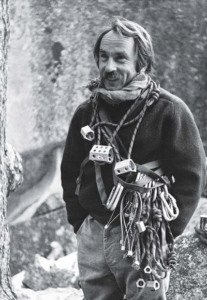
Quite a guy, he reminisces in an article that he would rock climb at Chatsworth in the morning, then surf in Rincon, and free dive for lobsters and abalone off the coast between Zuma and county line for his dinner. His swath has only grown wider; his philanthropy more profound.

Chouinard is known as a rock climber, environmentalist, philanthropist, and outdoor industry businessman. He grew up in Lewiston, Maine, and went to Stanford Graduate School. Chouinard is also a surfer, kayaker, and falconer and fond of fly-fishing.
He founded Patagonia in 1973 and ran the company for over 50 years, beginning as an eccentric rock climber in Yosemite and becoming a “reluctant billionaire.” For years, Patagonia has been known for its commitment to protecting the environment. Patagonia is now operating in ten countries globally with factories in 16 countries.
Patagonia, based in Ventura, California, now sells more than a billion dollars worth of outdoor gear each year. And that will continue, now operated by a specially designed trust. Its profits will flow to another entity, Holdfast, that will distribute the money to organizations potent in climate mitigation.
Quote of the Week: Electrolyzers 101
“At the most basic level, water is provided to the electrolyzer stack, which looks like a multi-decker sandwich. The layers use a special membrane painted with a catalyst to separate the water into hydrogen and oxygen, using electricity to power the reaction.”
Clean Power Matches California’s Heat Wave

For two weeks in September California was blasted by a heat wave, the hottest and longest on record. And guess what? The grid remained stable. There were not the feared rolling black-outs. Why did we get through? Some say, “Because we are all in on clean energy technologies like wind and solar and battery storage and demand response.”
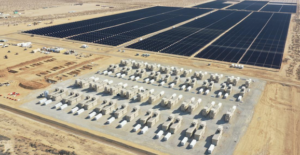
Image Courtesy of Terra-Gen / CPA
Without question, the combination of the rapid growth of storage, and all kinds of efforts to reduce power demand, were key to avoiding blackouts. This month’s recent history shows that the power system can decarbonize and still stand up to climate extremes.
Let’s start with batteries. The California grid has the most installed battery capacity on any grid worldwide, according to Forbes. In the last intense heat wave, in 2020, the State had about 250 MW of battery storage. Today, there is 3,050 MW of storage, more capacity than the Diablo Canyon nuclear plant. California is home to the world’s largest battery at Moss Landing. Note that in 2020, the State had a hard time meeting a peak demand of 45,000 MW. Earlier this month, the ISO topped 52,000 MW… and still kept the lights and AC on.
On September 6th, the eighth day of the historic heat wave, and at 2:30 in the afternoon, the California Independent System Operator (CAISO) notified utilities and consumers that a Level Three Emergency would begin at 5:30. The CAISO warned that there was a potential for rolling blackouts as solar production would wane away at the end of the day. At 5:30 the Level Three Emergency was declared. Given this designation, market participants were encouraged to offer more energy bids. Black-outs were looming.

And then at 5:48 a timely mobile alert from the California Office of Emergency Services may have prevented hundreds of thousands of Californians from being plunged into darkness in the middle of a heat wave . The text asked Californians to conserve to avert outages. And the notice is credited with the sharp drop in demand. Within an hour the grid had dropped 3,000 MW of load.
A number of things have changed in California since the last heat wave in 2020.
- We have more solar.
- We have more wind.
- Over 3,000 MW of energy storage started providing energy to the grid, and helped to stabilize the situation.
- Demand Response resources kicked in taking well over another thousand megawatts off the grid.
- Ohm Connect sent six million communications to its 200,000+ active members who toggled smart energy devices and saved 1.5 GWh during the peaks of the nine-day heat wave, and earned $2.7 million in rewards.
- One of the new Demand Response programs for large customers is the Emergency Load Reduction Program (ELRP). It pays up to $2/kWh during critical periods. Customers are even allowed to turn on their diesel generators to cut their import of power from the grid.
- Ten days of Flex Alerts kept Californians on their toes, voluntarily avoiding unnecessary peak power use.
- Tuesday, September 6th, was the hottest day of the heat wave and the day of greatest grid stress. A new peak of 52,061 significantly eclipsed the prior peak of 50,270 set in July 2006. Blissfully the wind picked up in that evening and provided 2,700 MW of power.
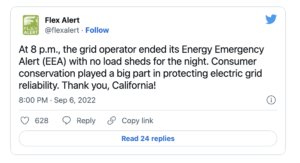
Clearly, California is on the right path. Our clean energy portfolio is starting to work in our favor. The complement of solar, wind, storage, demand response, and voluntary actions was successful. Earlier this year, the California Public Utilities Commission (CPUC) issued its preferred system plan that calls for 15,000 MW of new energy storage and demand response programs resources by 2032.
Inflation Reduction Act of 2022

To many of us, the Inflation Reduction Act (IRA) is a massive step in the right direction. It’s time to invest in climate protection. While many readers will already be well aware of the IRA, we can’t resist including it in this month’s EcoNet News. IRA’s funding is profound. According to John Paul Meija of the Sunrise Movement, the bill is an important step “in the decades-long, intense decarbonization effort in this country.”
Within the IRA, which includes provisions for prescription drug pricing and health care access, are the Energy Security and Climate Change Investments. The Congressional Budget Office’s “official score” of the final version of the IRA states that the $700 billion package includes $386 billion of climate and energy spending and tax breaks.
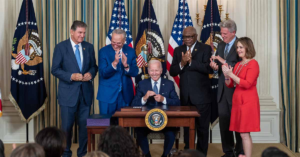
Image Courtesy of Solar.com
Without question, the IRA represents the single biggest climate investment in U.S. history. The grants and tax credits are for new or expanded tax credits to promote clean energy generation, electrification, green technology retrofits for homes and buildings, greater use of clean fuels, environmental conservation, and wider adoption of electric vehicles. The IRA’s goal is to put the country on track to achieve a 40% reduction of greenhouse gasses below 2005 levels by 2030. Before the IRA, the nation had been on a 25% reduction trajectory.
Some claim that the IRA doesn’t go far enough. But it’s a big step. The bill offers “a significant bump” in the nation’s ability to reduce GHGs, according to a Duke University director. One summary suggests that the IRA contains no less than 25 climate and energy provisions… from tax credits to grants and rebates. Here are highlights for consumer funding:
- $9 billion for home energy rebate programs, things like heat pumps
- 10 years of consumer tax credits, including restoration of the 30% solar ITC
- $4,000 in consumer tax credits for lower and middle income who buy used electric vehicles, and $7,500 for those that buy new EVs
IRA provisions for domestic mining of materials that are needed to make solar panels and batteries, as well as for the offshore wind industry, like large ships that are needed to build offshore wind farms. The bill includes $60 billion to support onshore clean energy manufacturing as well as:
- $30 billion in production tax credits to help us manufacturers accelerate production of solar panels, wind turbines, and batteries and process key materials
- $10 billion investment tax credit, for new manufacturing facilities that make clean technologies like electric vehicles, wind turbines, and solar panels
- $500 million for the Defense Production Act to speed processing critical materials
- Up to $20 billion in loans for new manufacturing facilities for clean vehicles
The IRA does include significant concessions for the fossil fuel industry. It could result in fast-tracking construction of a natural gas pipeline in West Virginia. The bill also funds carbon capture and storage… a move to extend the life of the fossil fuel industry. The bargain also ties the leasing federal lands for wind and solar with specific acreages offered up for oil and gas production.
Green Hydrogen Electrolyzers
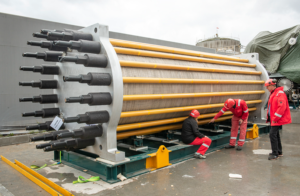
Image Courtesy of HydrogenPro
Some friends scoff at the notion of green hydrogen. They say it’s long and far away; that it’s costly and inefficient to convert from water to hydrogen, and then to create electricity. And they may be right, but big players are jumping into the green hydrogen space. There’s lots of action in this space.
The word “lysis” means to break down, in this case, to break down water using electricity. Through “electrolysis” an electric current is applied to water to split it into its component elements, hydrogen and oxygen. We’re after the hydrogen!
Electrolysis is ~80% efficient, meaning that 80% of the value of the electricity used to create the hydrogen, is retained in the hydrogen. It takes 20% of the value of the electricity to make the hydrogen. Put another way, the energy value of the hydrogen produced is 80% of the electricity’s value used to split the molecule.
The world’s largest manufacturer of electrolyzers is Norwegian company NEL. It has business operations in 80 countries and roots back to 1927. It’s a global company dedicated to producing, storing, and distributing hydrogen from renewable energy.
NEL recently teamed up with Spanish Iberdrola for green hydrogen production. Together, they will develop and deploy large-scale electrolyzer projects. Iberdrola has formed a new business entity – Iberlyzer – to focus on electrolyzers. The business goal is to integrate over 200 MW of electrolyzers in 2023.
HydrogenPro has announced that the world’s biggest electrolyzer has arrived at its facility in Heroya, Norway. It was made in Tianjin, China and will produce 100 kilograms (kG) of pure hydrogen per hour. The electrolyzer is a long cylinder six and half feet in diameter.
Siemens and German utility SWW Wunsiedel plan to commission a 8.75 MW electrolyzer in Bavaria. Hydrogen there will be produced primarily with solar and wind. An even larger 10 MW would produce 4,500 kG per day. That would support 50 buses or 900 cars based on average usage. A new hydrogen power plant planned for operation in Namibia by 2024 will be solar powered.
Plug Power, or just Plug, offers a range of electrolyzer products. Leading companies include Plug, NEL, ITM Power, John Cockerill. Other companies in this space include Bloom Energy, Cummins, Thyssenkrup, and Siemens.
By the way, today most hydrogen is created through steam reformation, a process where a stream of natural gas is mixed with high-temperature steam in the presence of a catalyst. The output is a mix of CO2 and hydrogen. The process is 65% efficient.
Little Free Library Movement

This seems like good news. Old fashioned perhaps, but with the most altruistic of sentiments indeed. Sharing books… not links for tablets, but hard copy books to inspire reading and readers. The Little Free Library organization and its host sites, have expanded access to reading.
Little Free Library is now not just a concept, but an organization that was formed in St. Paul, Minnesota. It’s grown to be a network of unmanned mini-lending libraries in different areas of the community that anyone can make use of. There are more than 150,000 registered LIttle Free Library book sharing boxes in 115 countries. There are more than 50,000 in the United States. Little Free Library is a registered 501(c)3 nonprofit org.
The mini-libraries are part of a longstanding tradition. Think bookmobiles serving rural communities; apparently there’s the “Biblio-Burro” in Colombia. A Little Free Library is a book-sharing box where anyone can take a book or share a book. They function on the honor system. You do not need to share a book in order to take one. And if you want to host a library, you can even buy community book sharing boxes on Amazon.
Another take on this is Pop-Up Libraries, an Australian organization promoting books creatively. Its temporary locations get attention. Pop-Up Libraries is an artist-led, social initiative that establishes small libraries in public spaces, like community and art centers. Pop-Up has a great mission. Its libraries are catalysts for reading. They encourage recycling.
The mini libraries also inspire creativity. An example, the Whitsunday (Australia) Regional Council supports mobile libraries by fielding small trailers that open up to display books at beaches and other sites in rural communities. There’s a floating library built on a raft on a lake in Minnesota, accessible by kayak. Its bookshelves feature a collection of artist-made books and printed matter.
Air Canada Orders Electric Planes

Image Courtesy of CNW Group/Air Canada
Air Canada has ordered 30 electric planes from Heart Aerospace, a Swedish aviation company. The Canadian airline also acquired a $5 million equity stake in Heart. The ES-30 planes are slated to be in service in 2028. The four-propeller planes hold 30 passengers and have a range of 125 miles.
The current range limitation makes them well suited to fly short haul routes, like Palm Springs to Los Angeles, or Denver to Aspen. The flights are emissions free and the electric plans will require considerably less maintenance than their fuel burning brethren. They can also be recharged between flights in 30 minutes.
In related news in 2021, United Airlines and its regional partner Mesa Airlines, bought 200 Heart Aerospace ES-19s. Those are expected in the friendly skies in 2026.
Flanigan’s Ego-Logic Podcast Updates
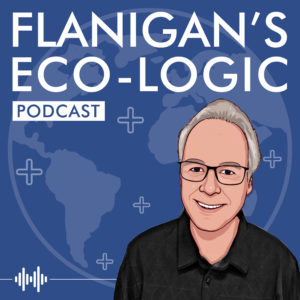
Lots to report on the podcast front. I’ve had great conversations this past month! You can use the links below to check out our recent podcasts. And you can always go to Spotify and type in “Ted Flanigan” or just “Flanigan” to access our library of 100+ podcasts.
Recently Released:
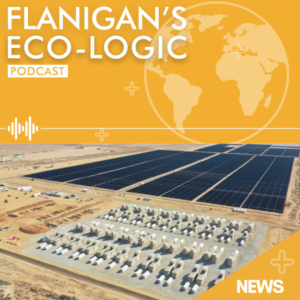
This issue of EcoNet News, Volume 24, Issue #9 is also available in podcast format. It features Yvon Chouinard and his family’s gift of Patagonia to fight climate change. It also salutes Californians all who defeated proclamations of rolling black-outs and effectively kept the power grid on. We dig into the Inflation Reduction Act and its climate and energy funding and implications. Other stories feature Green Hydrogen Electrolyzers, the Little Free Library movement, and Air Canada’s purchase of electric planes.

In this episode, Father – Daughter Duo, Ted and Sierra Flanigan, hold a Crash Course on offshore wind. They have a lively discussion on its fantastic potential, and unpack its challenges and its benefits. So far, there are seven Crash Courses that aim to demystify energy and environmental issues and opportunities.

In this episode, Ted speaks with Walter “Wally” McGuire, Retired CEO of the Flex Your Power Campaign. Ted and Wally discuss his background and early career in campaign organizing, White House trip planning for President Jimmy Carter, his involvement in two Olympics, and managing the Pope’s visit to Los Angeles. He also highlights his role in developing and managing the enormously successful Flex Your Power Campaign for 15 years, demonstrating the importance of thanking the public for helping to avert blackouts versus them thinking that their contribution was not meaningful.

In this episode, Ted speaks with Mona Newton, former Executive Director of CORE (Community Office of Resource Efficiency), serving Aspen and Pitkin County, Colorado. CORE is an interesting community energy model made up of elected officials, utility representatives, and committed citizens to help people, businesses, municipalities, facilities and nonprofit organizations save natural resources and lower energy bills while reducing their carbon footprint.
Mona highlights three of CORE’s programs and projects: placing fees on mega-home developers to offset their carbon footprints, the genesis of the 5 MW solar farm near the Aspen Airport, as well as CORE’s work with capturing methane from abandoned coal mines, notably the five mines that constitute Coal Basin.

In this episode, Ted speaks with Lauren Faber O’Connor, Chief Sustainability Officer for the City of Los Angeles. Ted and Lauren discuss her early career at the British Embassy promoting sustainability solutions, as well as the relationship between British Prime Minister, Tony Blair, and California Governor, Arnold Schwarzenegger, which led to her moving home to California to serve as Assistant Secretary of the California EPA for Climate.
She goes to share how she landed back in Los Angeles to work for Mayor Garcetti to serve as deputy, and then Chief Sustainability Officer for the City of Los Angeles, highlighting LA’s unique role and its opportunity to create a potent model for sustainability. She digs into the breadth of environmental and equity issues the Mayor has spearheaded, and the responsibility and opportunity that LA has to serve in a local government leadership capacity.

In this episode, Ted and David have a substantive discussion ranging from the roots of his environmental passion in Tehran, Iran as a child, to his long standing and official role as a Member of the Los Angeles Regional Water Quality Control Board. He’s been appointed by four governors to this position. A division of Cal EPA, the Board is responsible for potable water, non-drinking water, stormwater, ocean waters and more throughout the region made up of 99 cities.
The current three-year drought is a big part of the conversation. David discusses the drought and its motivating effect as water supplies become scarce and more costly. This drives opportunities for local leadership and investments in efficient water use and reclamation. He salutes Orange County’s wastewater reclamation. And while Los Angeles may not zero-out imports of water, the region is now on a trajectory to lead the nation in managing water resources now further threatened by climate change.
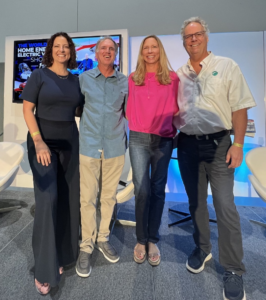
Ted was on a panel at Fully Charged in San Diego, with April Buldoc of S Curves, James Richmond of SunWater Marine, and Karin Burns from San Diego Community Power, discussing the clean power ramifications of electrifying mobility and buildings.
